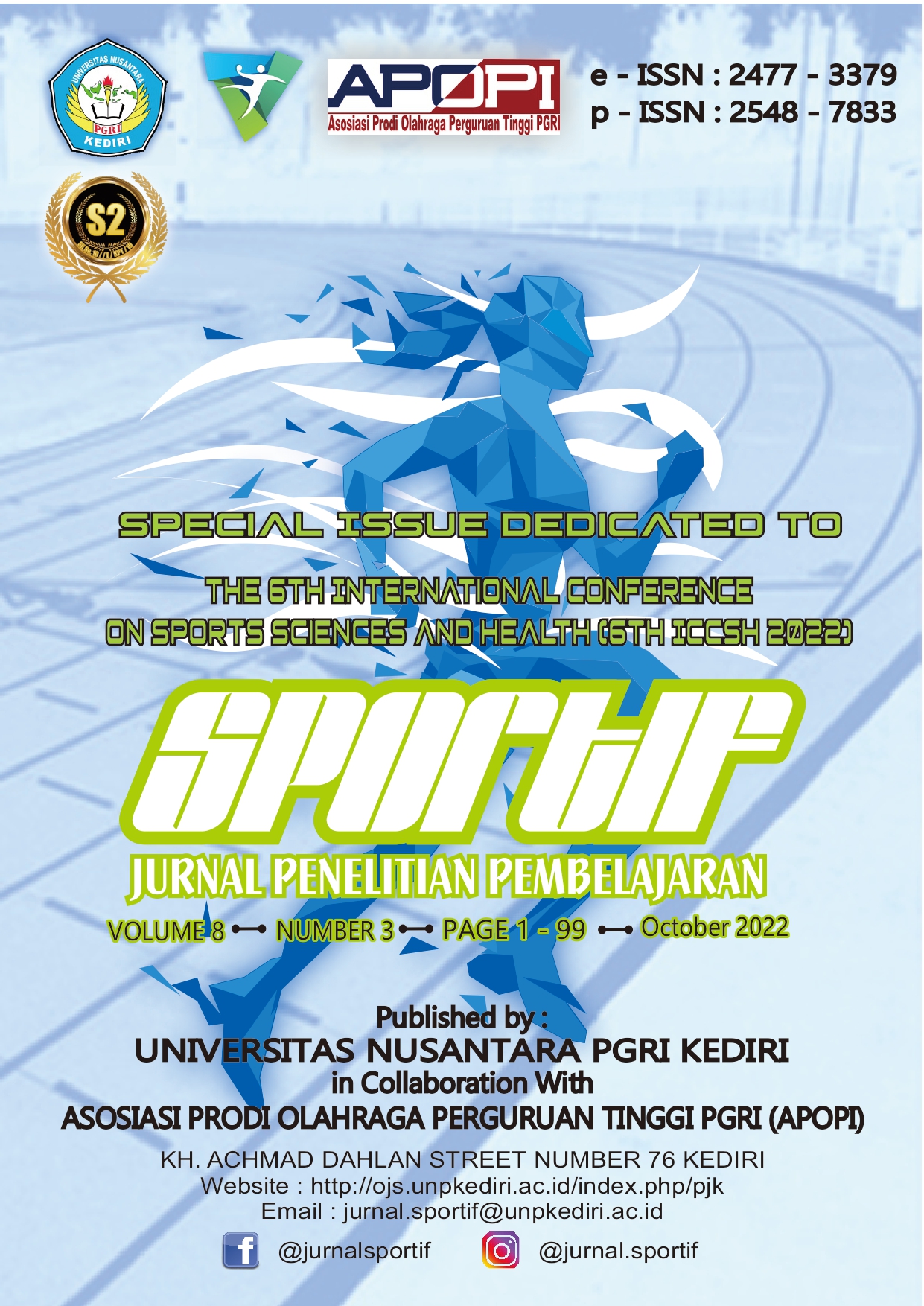Abstract
Sports that require speed for the Athlete to reach the finish line with the fastest time will be the winner in a speed skating race. With the demand to recap the speed of the alet entering the finish line, it is necessary to calculate the time that can be used in a speed skate race. Tools such as stopwatches have been used without weaknesses in the device, but weaknesses often arise from human error and result in many athletes being harmed. So we need a tool that can record athletes' speed without any errors so that athletes' speed can be recorded. This research aims to develop a speed-measuring instrument by utilizing radio signals or RFID to minimize human error in the race. This research uses research development methods (Research and Development). The timekeeper uses an identity tag attached to the skate and a sensor reader (Tag Reader) to detect the time. The study results show that RFID for recording time in roller skates is already valid and feasible. The development of this tool RFID, RFID, can detect the identity of the time between the Tag and Tag Reader with a maximum distance of 3m. Using this tool can improve the ability to record time in roller skating to record the time produced by athletes when reaching the finish. The use of this tool is practical and easy, so it is in accordance with the regulations in roller skating and as needed in the sport. The timing system will work when the Tag passes the Tag Reader attached to the start/finish line in a speed skating race.
References
Fernandez, S., & Wiyata Mandala, Y. (2022). Implementasi Teknologi RFID Pada Aplikasi Buku Tamu Undangan. Jurnal Komputer Terapan, Vol. 8 No. 1 (2022). https://doi.org/10.35143/jkt.v8i1.5335
Fescioglu-Unver, N., Choi, S. H., Sheen, D., & Kumara, S. (2015). RFID in production and service systems: Technology, applications, and issues. Information Systems Frontiers, 17(6). https://doi.org/10.1007/s10796-014-9518-1
Hunt, V. D., Puglia, A., & Puglia, M. (2006). RFID-A Guide to Radio Frequency Identification. In RFID-A Guide to Radio Frequency Identification. https://doi.org/10.1002/0470112255
Kardiyono, K., & Rohidi, T. R. (2019). Aktivitas Bersepatu Roda Sebagai Refleksi Gaya Hidup Generasi Masyarakat Kota Semarang. Jurnal Ilmiah Spirit, 19(1). https://doi.org/10.36728/jis.v19i1.956
Maryono. (2005). Dasar-dasar Radio Frequency Identification (RFID), Teknologi Yang Berpengaruh di Perpustakaan. In Media Informasi (Vol. 14, Issue 20, pp. 18–29).
Meng, Z., & Li, Z. (2016). RFID Tag as a Sensor - A Review on the Innovative Designs and Applications. Measurement Science Review, 16(6), 305–315. https://doi.org/10.1515/msr-2016-0039
Nugraha, A., Daniel, D. R., & Utama, A. A. G. S. (2021). Improving multi-sport event ticketing accounting information system design through implementing RFID and blockchain technologies within COVID-19 health protocols. Heliyon, 7(10). https://doi.org/10.1016/j.heliyon.2021.e08167
Olaby, O., Hamadache, M., Soper, D., Winship, P., & Dixon, R. (2022). Development of a Novel Railway Positioning System Using RFID Technology. Sensors, 22(6). https://doi.org/10.3390/s22062401
Orbia, R. H., Deiny Mardian, R., & Sari, L. (2020). Rancang Bangun Kunci Loker Otomatis Berbasis Raspberry Pi Dan Rfid Untuk Meningkatkan Efisiensi Waktu. Jurnal Pendidikan Teknik Elektro Undiksha, 9(3), 151–160.
Rezaiesarlak, R., & Manteghi, M. (2015). Chipless RFID: Design procedure and detection techniques. In Chipless RFID: Design Procedure and Detection Techniques. https://doi.org/10.1007/978-3-319-10169-9
Rozy, F., & Fahruzi, I. (2022). Sistem Pengaman Loker Menggunakan Smart Card PN532 RFID/NFC. Jurnal Integrasi, 14(2). https://doi.org/10.30871/ji.v14i2.4503
Saputra, B. A., & Indra, E. N. (2019). Profil kondisi fisik atlet sepatu roda daerah istimewa yogyakarta. Medikora, 18(2). https://doi.org/10.21831/medikora.v18i2.29199
Sugiyono. (2010). Metode Penelitian Pendidikan, pendekatan kuantitatif (p. 12).
Suryawati, S., Brustiando, R., Himawanto, W., & Pratama, B. A. (2022). Analisis tingkat self confidence pada atlet sepatu roda. Sriwijaya Journal of Sport, 2(1). https://doi.org/10.55379/sjs.v2i1.479
Syarif, A. (2022). Aktivitas Sepatu Roda Sebagai Olahraga Rekreasi Masyarakat. Prosiding Seminar Nasional Universitas PGRI Palangka Raya, 1. https://doi.org/10.54683/puppr.v1i0.23
Valentino, R., Nachrowie, N., W, D., & Mujahidin, I. (2020). Rancang Bangun Sistem Penilaian Kesegaran Jasmani A Di Jajaran TNI-AD Berbasis RFID. JASIEK (Jurnal Aplikasi Sains, Informasi, Elektronika Dan Komputer), 2(1), 98–106.
Wijayanto, A., & Sasmoko, P. (2015). Pengoperasian rfid sebagai operating user parking area dengan metode elektronik parking pricing (epp) berbasis arduino uno. Gema teknologi, 18(3). https://doi.org/10.14710/gt.v18i3.21932
Yao, W., Chu, C. H., & Li, Z. (2010). The use of RFID in healthcare: Benefits and barriers. Proceedings of 2010 IEEE International Conference on RFID-Technology and Applications, RFID-TA 2010, July, 128–134. https://doi.org/10.1109/RFID-TA.2010.5529874
Yoandhita, T. (2020). Penerapan Teknologi Radio Frequency Identification (Rfid) Pada Sistem Pergudangan Menggunakan Metode Fuzzy Tsukamoto. Repository.Unsri.Ac.Id.
Zhang, T., Jiao, C., Sun, H., & Liang, X. (2022). Application of Internet of Things Combined with Wireless Network Technology in Volleyball Teaching and Training. Computational Intelligence and Neuroscience, 2022. https://doi.org/10.1155/2022/8840227
Authors who publish with this journal agree to the following terms:
- Copyright on any article is retained by the author(s).
- The author grants the journal, the right of first publication with the work simultaneously licensed under a Creative Commons Attribution License that allows others to share the work with an acknowledgment of the work’s authorship and initial publication in this journal.
- Authors are able to enter into separate, additional contractual arrangements for the non-exclusive distribution of the journal’s published version of the work (e.g., post it to an institutional repository or publish it in a book), with an acknowledgment of its initial publication in this journal.
- Authors are permitted and encouraged to post their work online (e.g., in institutional repositories or on their website) prior to and during the submission process, as it can lead to productive exchanges, as well as earlier and greater citation of published work.
- The article and any associated published material is distributed under the Creative Commons Attribution-ShareAlike 4.0 International License





